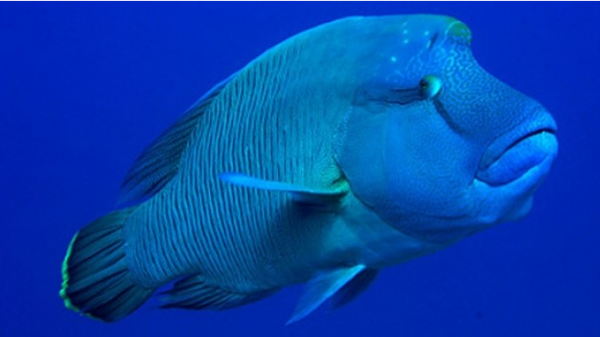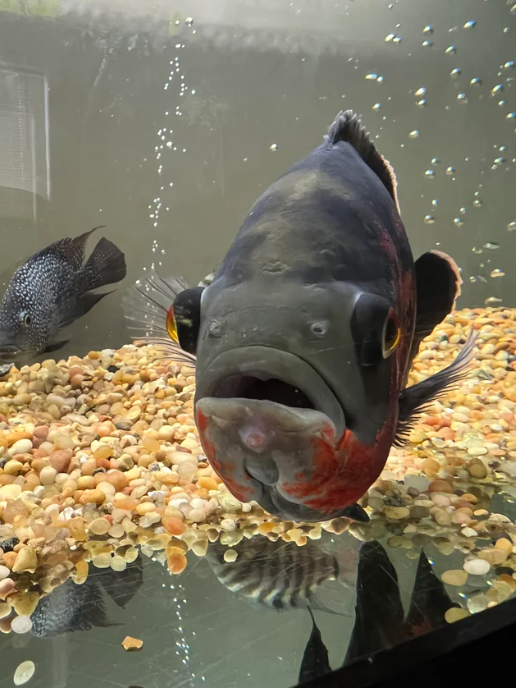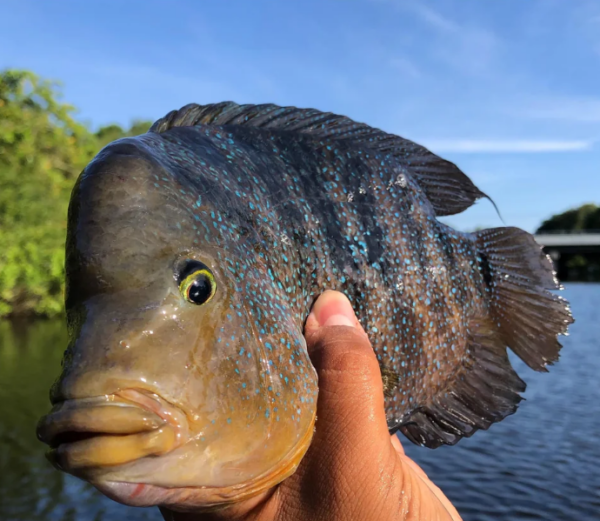Result of either benign growth or serious diseases, the “Fat Lip” or “Duck Lip” issue develops swollen lips and multiple related symptoms in your pet fish. Depending on the nature of the issue, it often proves to be fatal.
On the other hand, it frequently occurs in nature as a physical maturation. Flowerhorn, Humphead Wrasse, and many other fish species naturally possess thick lips that enhance their attractiveness and value in the aquarium trade.

In this article, we’ll go through the fat lip fish issue and the reasons behind its occurrence in your tank.
Table of Contents
What Is the Fat Lip Fish Issue?
Disregarding the natural cases, fat lip fish issue usually occurs as a result of viral, bacterial, and fungal infection, and injury. The telltale sign of fat lip disease is the fat lips, but many other symptoms often follow.
However, the fat lip fish issue isn’t a single variance of disease. Bacterial infections like columnaris and aeromonas, viral infections like Malawi bloat, and many fungal infections cause swallowing in the mouth. They’re commonly termed as the fat lip fish issue.
Therefore, it’s important to observe other symptoms when determining the cause behind your fish’s fat lips. If you’re still unsure of the cause, consult a veterinarian or aquarist before intervention.
Symptoms of Fat Lip Fish Issue
Here is a list of symptoms with the details of their associated diseases that may help you determine the underlying cause.
1. Swollen Lips
Unusually swollen lips, self-evidently, is the primary symptom of fish fat lip issue. In the initial stages, the lips show subtle inflammation that ultimately swells into tumor-like structures. If kept unchecked, it hinders the eating and physical habits of the fish.
As swollen lips are often a result of bacterial or viral outbreaks, they usually attack the whole tank if the affected fish isn’t isolated or left untreated. The fatality of this symptom often increases with time and the occurrence of other injuries.
A few diseases that may cause swollen lips in fish are:
- Columnaris
- Aeromonas
- Mycobacteriosis
- Malawi bloat
- Saprolegnia
- Achlya
- Ich
- Argulus
2. Mouth Rot
Mostly caused by the bacteria Flexibacter columnaris, mouth rot is a serious symptom that can affect both freshwater and saltwater fish. They usually enter the fish’s body through openings in the skin, such as a wound or a sore.
It multiplies quite rapidly and spreads to the fish’s mouth and fins, causing fat lip disease. While it’s quite visible in the later stages, the initial signs of mouth rot include:
- Fins with blood streaks
- Torn, tattered, and frayed fins
- Feathery fins and mouth area
- Decaying lips with cottony growth
- Cottony growths of body and fins
3. White or Yellow Lesions on the Body and Fins
Smooth or scaly lesions are often visible on the fish’s body and fins as an associated symptom of fat lip issue. In most cases, It’s accompanied by other symptoms like lethargy and loss of appetite. Skin lesions mostly grow on the mouth and fins of the fish, which look like loose white or yellow food residue left on the mouth.
White or yellow lesions aren’t exclusive to fat lip issues. But they’re often the result of bacterial and fungal infections that cause the same. Go through the other symptoms mentioned in this section to identify the exact cause of fat lip issues in your fish.
The common diseases that cause lesions on the body and fin are:
- Columnaris
- Aeromonas
- Mycobacteriosis
- Saprolegnia
- Achlya
- Ich
- Argulus
- Anchor worms
- Skin flukes
- Velvet
- Chilodonella
- Trichodiniasis
4. Lethargy
Lethargy is one of the most common symptoms of fat lip issues. Whether the issue has been caused by mild injury or bacterial outbreak, lethargy is likely to follow as a symptom. Poor water quality, improper temperature, overfeeding, and stress may also trigger the symptoms in your fish.
Lethargy should be considered as a warning sign. Monitor your lethargic fish to observe any growth on their body and lips.
While some fish are naturally slack, here are a few typical lethargic behaviors that may help you determine fat lip issues:
- Sluggish movement. Your lethargic fish will show minimal to zero interest in swimming and moving from their spot. They often lose interest in exploring the environment.
- Isolation. They may isolate themselves from other fish and seek shelter in corners.
- Listlessness, Lethargic fish lose their usual activity and alertness.
- Change in coloration. Your lethargic fish may become dull or faded. They may also develop unusual spots.
- Uncoordinated swimming patterns. Your fish may exhibit erratic swimming patterns.
- Clamped fins. An ill and lethargic fish may clamp their fins towards their body.
5. Loss of Appetite
A fat lip fish, in addition to their physical inability to feed, may lose appetite altogether. Bacterial and parasitic infections being energy exhaustive, priority is given to the immunity system rather than feeding and exploring.
6. Breathing Difficulty
Labored breathing is another prominent symptom of underlying issues and fat lip disease. Increased gill movement, rapid breathing, and gasping for air are common with fat lip fish.
Other diseases that may also cause breathing difficulty, are:
- Dropsy (Ascites)
- Gill Flukes (Dactylogyrus)
- Ichthyophthirius (Ich or White Spot Disease)
- Gill Infections (Bacterial, Viral, Fungal)
- Columnaris (Cotton Wool Disease)
- Ammonia Poisoning
- Koi Herpesvirus (KHV)
- Oxygen Deprivation
Causes and Treatments of Fat Lip Fish Issue

After you’ve deduced the exact reason for the fat lip fish issue, proper treatment procedures can be facilitated. While the treatments discussed in this section are quite effective, it’s advised to consult your aquarist before administering any medication.
1. Bacterial Infection
Columnaris or Cotton Wool Disease is the predominant bacterial infection known to cause fat lip issues. The symptoms of this disease include:
- Ragged and frayed fins
- White fungus-like appearance on body, fins, and mouth
- Rapid breathing
- Lethargy
Treatments for Columnaris revolve around administering gram-effective antibacterials like Kanaplex and Furan-2. Isolation and clean water are also necessary to start treatment. While the popular belief is that antibiotics need to be mixed in water, the infections are best treated with food.
Fin Rot is another infection that’s worth mentioning. It’s a bacterial disease that rots the fins and tail away, ultimately leading to loss of life. The general symptoms often include:
- Rapid discoloration of fins and tail
- Lethargy and appetite loss
- Frayed Fins falling off
- Irregular swimming patterns
Most effective treatments for fin rot revolve around providing a cleaner tank and an appropriate environment. Erythromycin and methylene blue are particularly effective medications when the condition has worsened.
Mycobacterium (Fish TB) may also cause fat lip fish issues. As the external symptoms may stay dormant for years before surfacing, true eradication of the disease is challenging. Antibiotics, such as kanamycin, erythromycin, and streptomycin, can be used if the disease is caught early. Otherwise, euthanization and tank sterilization are the best course of action to stop the outbreak.
Aeromonas is another gram bacteria that causes red sores, fat lips, and popped-out eyes. Effective treatment options include isolation and antibacterials.
Sometimes, the antibacterials kill the beneficial bacteria. Remove the biomechanical filtration system during the treatment process.
2. Viral Infection
Viruses are small infectious agents that require a host cell to replicate. Most viral infections in fish are eradicated by regular water changes and by providing a stress-free environment. Let’s discuss a few viral infections that may cause fat lip fish issues.
Lymphocystis or Cauliflower Disease is usually brought on by stress and the symptoms mostly include
- Nodular, irregular, wart-like growths on body and mouth.
- Popped-out eyes (exophthalmia)
- May alter swimming or breathing patterns if the nodules cover large portions
- Increased stress from not being able to feed properly
Isolation is the first step towards recovery. While there aren’t any known medications that may help with the growth, regular water changes and proper conditioning of the isolation tanks are effective in stopping the spread. ParaGard and aquarium salt may help alleviate their situation.
Betanodavirus is an RNA virus that causes appetite loss, lethargy, fat lip fish issues, and discoloration. This fatal disease may also cause scale loss, ulcers, and abdomen swelling in your fish.
As with any viral infection, the primary treatment for Nodavirus revolves around isolation and sanitization. Some antiviral medications, such as PVP-I, Recombinant interferons, and PACAP may help alleviate the situation.
3. Parasitic Infection
Caused by a variety of external and internal parasites, parasitic infections are pretty common in aquarium fish. External parasites, while visible to the naked eye, internal parasites live inside the body and are more difficult to diagnose.
Ich is one of the most common parasitic infections in aquatic environments. It’s pretty contagious and can stay dormant if the tank condition is kept ideal. Stress and a drop in water quality are the primary reasons behind ich outbreak.
Typical ich symptoms include:
- “Salting” on the fish’s body. Appearance of small white cysts.
- Troubled breathing
- Lethargy
- Fat lip fish issue if it spreads to the mouth.
Usual treatments for ich include Acriflavine and Metronidazole. Raising the water temperature, regular water changes, and Kordon Rid-Ich is equally effective in containing the outbreaks.
Velvet is a nasty parasitic infection caused by a parasite called photosynthetic dinoflagellate. It latches onto the fish’s body and reproduces rapidly in the presence of ambient light. The usual symptoms often include:
- Scratching against hard surfaces.
- Lethargy
- Loss of appetite
- Loss of coloration
- Fine yellow or golden film on the skin
- Fat lip fish issue
As it multiplies rapidly, cover your tank with dark curtains to contain the spread. Paraguard, copper sulfate, straight malachite green, and other OTC treatments effectively kill the parasite.
4. Injury
Fish often dart around the tank and explore the environment with their mouth. Mild injuries from these activities can result in fat lip fish issues and cause other infections if left untreated.
Fish Fights are pretty common in community aquariums with different types of fish species. The more aggressive fish species, such as Tiger Barbs, Red Tail Sharks, and Flowerhorn Cichlids can attack smaller and shy fish species like Angelfish and Tetras.
Decorations can prove to be hazardous to your fish. Hard collisions with sharp edges of the decorations can damage the lips of your fish and cause fat lip fish issues. Depending on the extent of the injury, parasitic and bacterial infections may also occur.
Handling issues can cause serious injury to your fish. Learn how to properly handle your fish while changing water or cleaning the tank to avoid such mishaps.
Scavenger fish species, like loaches and catfish, often scour through the substrates in search of food. Abrasion can occur in their mouth if the proper substrate isn’t used. Hard edgy substrates like small stones can maximize the probability of such an event occurring.
Treating mild injuries starts with isolating the victim in a quarantine tank. Keep the pH of the quarantine tank a bit lower to accelerate the healing process further. Monitor the fish for any signs of infections on the body and fins. Also, monitor their swimming and behavioral patterns to disregard the possibility of internal infections.
5. Nutritional Deficiency
As with any living creature, your fish requires specific nutritional elements to sustain their physiological functions. While they mostly get the nutrients from their diet, specific nutrient deficiencies that may cause fat lip fish issues and other infections are more prevalent than others.
Vitamin C deficiency is most common in fish species because of their inability to synthesize it in their body. It can weaken their immune systems and make them vulnerable to infections.
Vitamin D deficiency due to lack of adequate ambient lighting can cause poor calcium and phosphorus absorption. It can also weaken the bones and develop skeletal deformities.
Protein deficiency is potentially the primary cause of a weakened immune system and poor growth in fish. Offer your fish a balanced diet of live/frozen food and commercial pellets to avoid such issues.
Mineral deficiency, such as calcium and phosphorus deficiency can lead to stunted growth and a weakened immune system. Use commercial mineral additives in proper dosage.
6. Congenital Defects
Birth defects and structural abnormalities can cause fat lip fish issues. Congenital defects can’t be resolved by medication or other treatments. While surgery may be an option, the risks of such a procedure often outweigh the benefits.
How to Take Precautions Against Bacterial and Fungal Diseases
Fish diseases are the result of a weakened immune system or infiltration of external microbes. Minimization of both possibilities is the best preventative action for aquarium fish.
Here are a few points that you need to make a checklist of when setting up your new fish tank.
1. Reduce Stress
Stress weakens a fish’s immune system. The sources of stress can be traced back to:
- Prolonged logistics
- Poor water quality
- suboptimal water chemistry
- Inadequate filtration system
- Malnutrition
- Overcrowding
- Tank aggression and predation
Minimize the stressors to limit the possibility of an outbreak happening in your fish tank.
2. Regular Water Changes
Weekly 20-30% water change, followed by a monthly 90% water change can sustain your tank parameters and maintain your fish’s health. If possible, rinse the filter media with aquarium water, deep clean the decorations, and clean out the substrates once every few months to prevent parasitic growth.
3. Routine Filter Maintenance
Thoroughly rinse the bio media and replace it when required to maintain proper filtration. Make sure to not use any chemicals when rinsing the media and only use aquarium water. You need the beneficial bacteria growing in the sponges and bio balls to sustain a healthy aquarium.
4. Ensure Proper Nutrition
As mentioned before, provide your fish with a balanced diet of protein, vitamins, and minerals to build up their immunity and promote growth. Your fish’s robust immunity serves as an impenetrable barrier against any potential aquarium-invading microbes.
5. Prepare a Quarantine Tank
Whenever you come across new fish, always quarantine them before introducing them to the regular tank. Isolation makes it easier to identify existing issues and prevent any outbreaks. A quarantine tank also helps in isolating any already infected fish in the aquarium.
6. Prepare a Fish First-Aid
A sort of first-aid kit for fish should include:
- Quarantine tank with independent sponge filter, heater, and pump. Ensure the heater is powerful enough to raise the temperature to more than 86 degrees F.
- Aquarium salt can treat certain parasitic infections.
- Epsom salt for swelling and bloating.
- Water dechlorinator.
- Slime Coat Products like Seachem StressGuard.
- Dewormers like Prazipro.
- Kanamycin
- API General Cure
- Erythromycin
Depending on the nature of the tank (saltwater/freshwater), other medications and kits can be included.
FAQs
Bacterial infections, parasitic infections, viral infections, and injuries can cause fat lip fish issues and swollen lips. However, some fish also have naturally plump lips.
Diseases such as columnaris, Fish TB, lymphocystis, and ich often spread to fish lips and grow cysts. These are preventable by isolating the fish and treating them with proper medication.
The Bottom Line
We’ve discussed the fat lip fish issue prevalent in most fish aquariums as a result of various different kinds of infections and injuries. The proper medications and prevention strategies have been discussed in the article to help you manage the outbreaks.
No related posts.


